Canna 'Phasion' is a medium sized Italian Group cultivar; green, bronze and pink variegated foliage, ovoid shaped, branching habit; oval stems, coloured red; clusters of flowers are open, tangerine-orange and burnt-red, staminodes are large, edges frilled, petals purple with farina, fully self-cleaning; seed is sterile, pollen is sterile; rhizomes are thick, up to 3 cm in diameter, coloured white and purple; tillering is average. Originally a spontaneous mutation, probably of Canna 'Wyoming', as it has been known to revert its foliage colour to that identical to that old cultivar. Sold in the US and elsewhere as Canna Tropicanna®, it was protected under US Plant Patent #10,569. Because the patent was issue on 1998-08-25, it has now expired and propagation is now allowed. The plant can be sold under its cultivar name Phasion.
The earliest record is dated 1955 in Rhodesia, now Zimbabwe, in the garden of a gentleman called Mr Rademeyer in the city of Bulawayo. The cultivar was already in the garden when he moved into the house.
This cultivar has been subject to much legal activity, details of which are available in the link below.
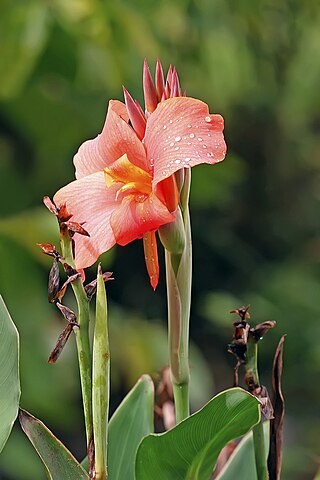
Canna or canna lily is the only genus of flowering plants in the family Cannaceae, consisting of 10 species. Cannas are not true lilies, but have been assigned by the APG II system of 2003 to the order Zingiberales in the monocot clade Commelinids, together with their closest relatives, the gingers, spiral gingers, bananas, arrowroots, heliconias, and birds of paradise.

Ficaria verna, commonly known as lesser celandine or pilewort, is a low-growing, hairless perennial flowering plant in the buttercup family Ranunculaceae native to Europe and Western Asia. It has fleshy dark green, heart-shaped leaves and distinctive flowers with bright yellow, glossy petals. It is now introduced in North America, where it is known by the common name fig buttercup and considered an invasive species. The plant is poisonous if ingested raw and potentially fatal to grazing animals and livestock such as horses, cattle, and sheep. For these reasons, several US states have banned the plant or listed it as a noxious weed. It prefers bare, damp ground and is considered by horticulturalists in the United Kingdom as a persistent garden weed; nevertheless, many specialist plantsmen, nursery owners and discerning gardeners in the UK and Europe collect selected cultivars of the plant, including bronze-leaved and double-flowered ones. Emerging in late winter with flowers appearing late February through May in the UK, its appearance across the landscape is regarded by many as a harbinger of spring.
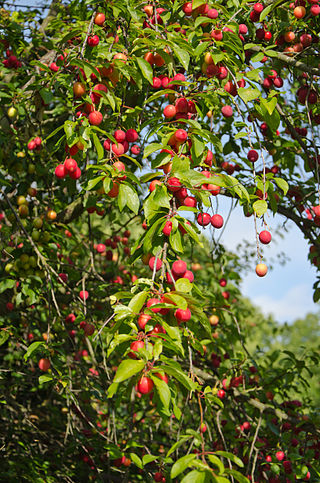
Prunus cerasifera is a species of plum known by the common names cherry plum and myrobalan plum. It is native to Southeast Europe and Western Asia, and is naturalised in the British Isles and scattered locations in North America. Also naturalized in parts of SE Australia where it is considered to be a mildly invasive weed of bushland near urban centers.
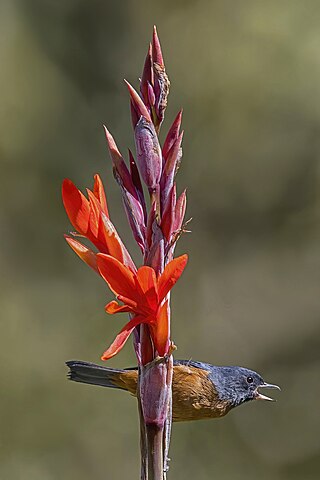
Canna indica, commonly known as Indian shot, African arrowroot, edible canna, purple arrowroot, Sierra Leone arrowroot, is a plant species in the family Cannaceae. It is native to much of South America, Central America, the West Indies, and Mexico. It is also naturalized in the southeastern United States, and much of Europe, sub-Saharan Africa, Southeast Asia, and Oceania. Canna indica has been a minor food crop cultivated by indigenous peoples of the Americas for thousands of years.

Nandina domestica commonly known as nandina, heavenly bamboo or sacred bamboo, is a species of flowering plant in the family Berberidaceae, native to eastern Asia from the Himalayas to Japan. It is the only member of the monotypic genus Nandina. It is widely grown in gardens as an ornamental plant with a number of cultivars that display bright-red fall foliage in the cool months, and attractive new foliage growth in spring. Although a popular ornamental shrub, the berries are toxic to birds, especially towards the end of the winter when other food sources become scarce.
Canna Italian Group 'Trinacria Variegata'. The earliest mention of this cultivar is in 1927, An Amateur in an Indian Garden by S. Percy-Lancaster, F.L.S., F.R.H.S., M.R.A.S., in which it was described and referred to by this name.
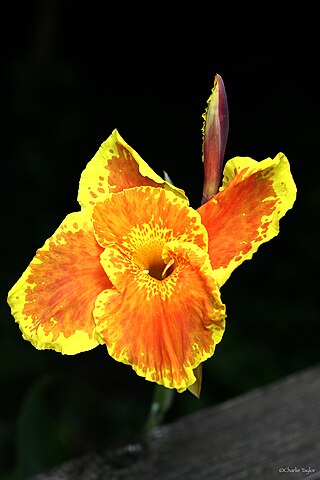
Canna Italian Group 'Roma' is a tall aquatic Italian Group cultivar, equally at home as a water marginal or in the border; large green foliage, oval shaped, white margin, upright habit; round stems, coloured green & purple; flowers are open, yellow with orange blotches, throat red-orange, staminodes are large, edges lightly frilled, stamen is orange-red, petals red, fully self-cleaning; seed is sterile, pollen is low fertile; rhizomes are long and thin, coloured white and pink; tillering is prolific. Introduced by C. Sprenger, Dammann & Co., Naples, Italy, EU in 1898.
Canna 'Austria' is a medium sized Italian Group Canna cultivar with green foliage, oblong shaped, upright habit; oval stems, coloured green; flowers are cupped, self-coloured yellow, throat orange-red spots on yellow, staminodes are large; seed is sterile, pollen is low fertile; rhizomes are long and thin, coloured white; tillering is prolific. Introduced by C. Sprenger, Dammann & Co., Naples, Italy, EU in 1893.

Canna 'Florence Vaughan' is a medium Crozy Group canna cultivar; green foliage, oval shaped, branching habit; oval stems, coloured green; flowers are open, yellow with red spots, staminodes are medium size, edges regular, fully self-cleaning; fertile both ways, not self-pollinating or true to type, capsules globose; rhizomes are thick, up to 3 cm in diameter, coloured white; tillering is average. Introduced by A. Crozy, Lyon, France in 1892.

Canna 'Madame Crozy' is a medium-sized 'Crozy Group' canna cultivar; green foliage, large, ovoid shaped, branching habit; oval stems, coloured red; spikes of flowers are open, scarlet with a narrow gold margin, throat gold with vermilion spots, staminodes are medium size, edges regular, petals red, fully self-cleaning; fertile both ways, not true to type, self-pollinating; rhizomes are thick, up to 3 cm in diameter, coloured purple; tillering is prolific. It was introduced by A. Crozy, Lyon, France in 1890 and was named in honour of his wife. It was awarded the RHS Award of Garden Merit (AGM), in 1890.
Canna 'Bengal Tiger' is an Italian Group canna cultivar with variegated foliage; plant height 190 cm; foliage height 140 cm; upright stems and gently spreading leaves; ovoid foliage, background of green (137A); veins variegated yellow, but paler in places (13D); maroon edge to leaf; staminodes, labellum and stamen bright orange (28B) blushed a darker, reddish (32A) in places; yellow (15A) on edges; stigma deep orange-red; petals strongly flushed red. The flower has a crumpled silk appearance; seed and pollen has very low fertility levels; rhizomes thick, up to 3 cm in diameter.
Canna 'Yellow King Humbert' Burbank is a medium sized Italian Group Canna cultivar; foliage green, but often variegated purple markings and occasionally whole leaves purple, oval shaped, spreading habit; oval stems, coloured green + purple; flower clusters are open, spotted, colours yellow with red spots, often large red markings and occasionally whole flowers red, staminodes are large; seed is sterile, pollen is sterile; rhizomes are long and thin, coloured white and purple; tillering is prolific.
Canna 'Roi Humbert' is an Italian Group canna cultivar; bronze foliage, ovoid shaped, spreading habit; oval stems, coloured purple; flowers are cupped, self-coloured scarlet, staminodes are large, edges ruffled, fully self-cleaning; seed is sterile, pollen is sterile; rhizomes are thick, up to 3 cm in diameter, coloured purple; tillering is average. Introduced by C. Sprenger, Dammann & Co, Naples, Italy, EU in 1908.
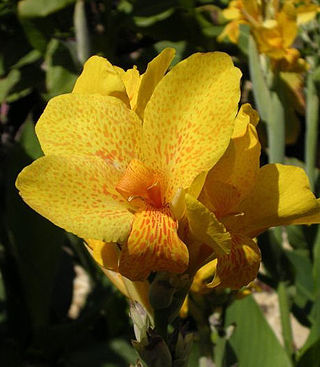
Canna 'R. Wallace' is a medium sized, Crozy Group canna cultivar; green foliage, oblong shaped, white margin, spreading habit; round stems, coloured green; flowers are open, pale yellow with red spots, staminodes are large, edges regular, stamen is rose-red with small yellow flecks; fertile both ways, not self-pollinating or true to type, capsules round; rhizomes are thick, up to 3 cm in diameter, coloured white and pink.
Canna 'Pringle Bay' is a miniature Italian and variegated group canna cultivar; variegated foliage, oval shaped, spreading habit; flowers are open, self-coloured pink, staminodes are large; fertile both ways, not true to type, not self-pollinating; rhizomes are thick, up to 3 cm in diameter, coloured pink and purple. Its main attraction is the bright variegated foliage, green, bronze and pink. Only about 40 cm in height.
Canna 'Musaefolia' is a cultivar in to the Foliage Group of Cannas. The cultivar was first described in the first work devoted to Canna, Le Canna, authored by M. Chaté in 1867 with Monsieur Théodore Année. The Musaefolia members of the Foliage Group consist of a specimen that was accepted as a native species of Peru by the experts of the time and at least 7 hybrids and cultivars carrying that parentage. The original "species" was unique because it was without rhizomes, and required to be kept constantly growing. No such species is known to exist in this age, and leading authorities treat C. musaefolia as a synonym of C. paniculata.
Théodore Année was a French horticulturist. He was a wealthy diplomatic consul in South America when he retired to France in the mid-1840s and settled in rue des Réservoirs, Passy, Paris, where he devoted himself to the culture of tropical plants from South America, having brought back with him the taste for plants with beautiful foliage, especially the Canna genus.

Penstemon digitalis is a species of flowering plant in the plantain family, Plantaginaceae. The flowers are white and are borne in summer. It is native to eastern Canada and the eastern and southeastern United States. Penstemon digitalis is the most widespread species of Penstemon east of the Mississippi River.

Acer palmatum, commonly known as Japanese maple, palmate maple, or smooth Japanese maple (Japanese: irohamomiji, イロハモミジ, or momiji,, is a species of woody plant native to Japan, Korea, China, eastern Mongolia, and southeast Russia. Many different cultivars of this maple have been selected and they are grown worldwide for their large variety of attractive forms, leaf shapes, and spectacular colors.